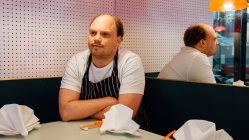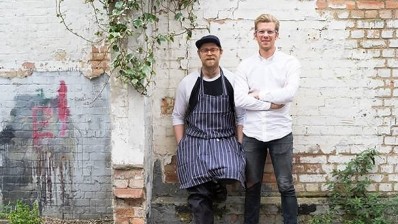Duck Duck Goose’s Oli Brown on running a Cantonese restaurant in a shipping container

We can’t help noticing you’re not Chinese...
Nope. I got a bit obsessed with the Cantonese roast meats restaurants in Queensway when I was working with Rowley Leigh at Le Café Anglais, most notably the Four Seasons. I loved the food and also the theatre of the hanging meats in the window. It also looked like a great restaurant model: affordable, busy and open late into the night. After Le Café Anglais I went to head the kitchen of The Continental in Hong Kong, which was being consulted on by Rowley. I was cooking French food out there but my wife and I ate a lot of great Cantonese barbecue and the idea for the restaurant was born.
How have you differentiated Duck Duck Goose from London’s established Cantonese roast meats joints?
I’m trying to do something in the middle. I’m not necessarily trying to do food that’s better than the Chinese-run siu mei places but I want to make the overall experience a bit better. At the majority of these places the decor is a bit dodgy, they don’t serve great drinks and the service is a bit brisk. We’ve gone for a more contemporary look that references the roast meat shops of Hong Kong. Our prices are a little bit more expensive than Chinatown, mainly because we’re using a great butcher.
Where do you get your recipes?
There’s been no Chinese mentor. I could have gone into a Chinese kitchen but I felt I’d done my time as a trainee. When I got back from Hong Kong I bought a load of Chinese cookbooks and took a temping job and cooked Chinese food at home for a year. I think what I’ve come up with is pretty good and I hope everyone else does, too.
What’s on the menu?
It’s pretty tight, it has to be with a kitchen the size of ours. Starters and sides include salt and pepper salsify; greens with dried chilli; and sesame, and prawn toast revisited, which is my take on the classic Chinese restaurant dish. I make it by sandwiching prawn mousse between two thin slices of bread and topping it with Kewpie mayonnaise, curly endive, kohlrabi and bonito flakes. For the main event, people can choose between Cantonese barbecue meats including char siu pork, roast duck and roast pork belly with five spice, or they can order a whole fish steamed with soy ginger and spring onion. We do a couple of desserts including cha chaan teng-style French toast with caramel and soy ice cream.
How have you found running a restaurant in a shipping container?
In the evenings we have four chefs in the kitchen. It’s intimate. I crossed paths with Will Bowlby (head chef and co-founder of Kricket) while working for Rowley. He launched Kricket in the same development we are in so he gave us a lot of very useful advice. This shipping container is intended to be a springboard to a bricks and mortar site. I’m ambitious and the model is scalable. Eventually I’d like to have a few.






























